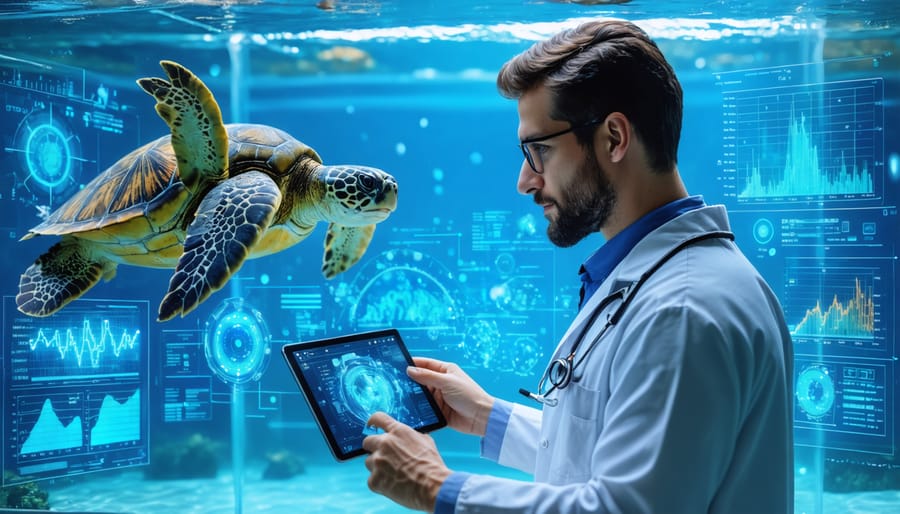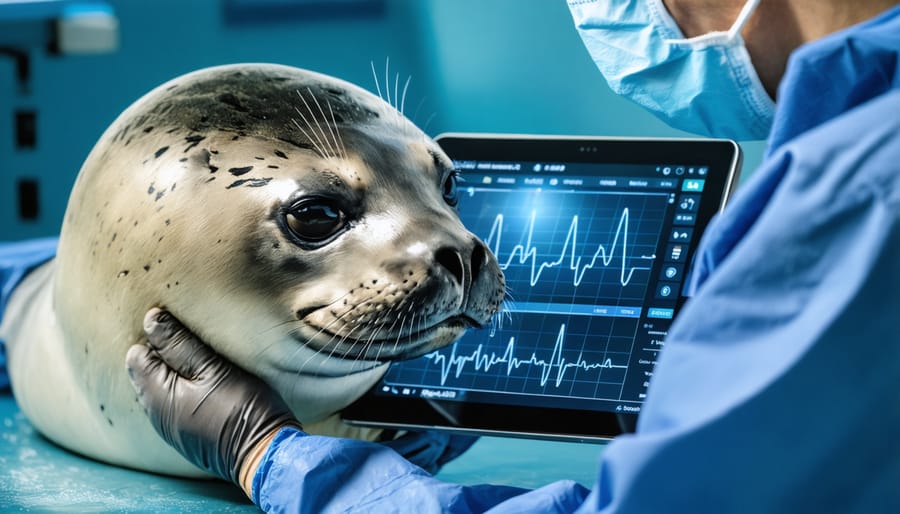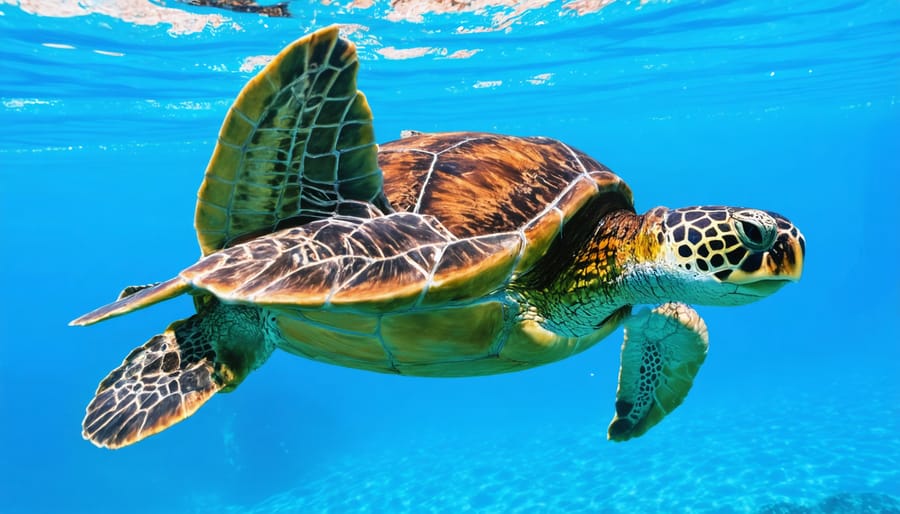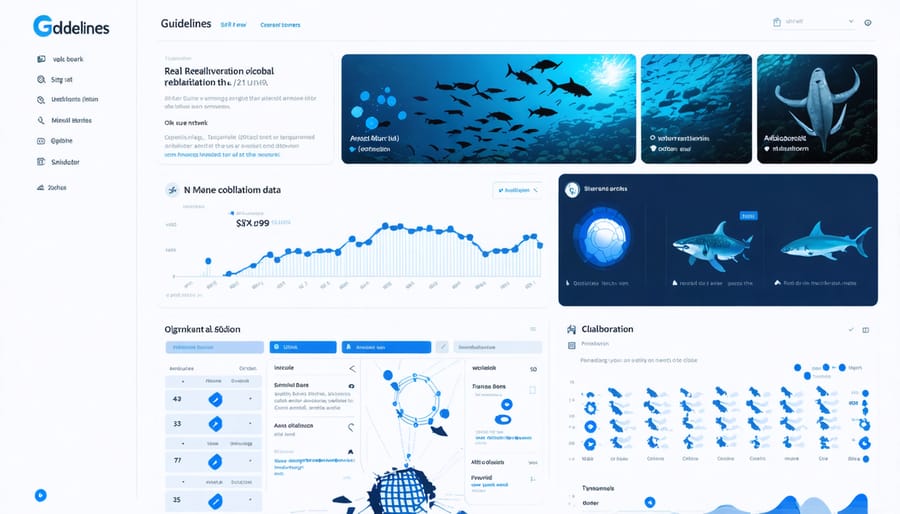
Every day along our coastlines, dedicated teams of marine scientists and veterinarians work tirelessly to rescue, rehabilitate, and release injured marine animals back into their ocean homes. Modern technology has revolutionized how marine life centers approach wildlife rehabilitation, transforming what was once a largely manual process into a precise, data-driven science. From advanced imaging techniques that diagnose internal injuries without invasive procedures, to satellite tracking systems that monitor released animals’ progress, these innovations have dramatically improved survival rates among rescued marine species.
The integration of artificial intelligence, remote sensing, and biotechnology has created unprecedented opportunities for understanding and treating marine animals’ complex medical needs. These technological breakthroughs not only enhance treatment effectiveness but also provide valuable insights into marine ecosystem health and species conservation. As climate change and human activities continue to impact ocean environments, these rehabilitation techniques serve as a crucial lifeline for maintaining marine biodiversity and protecting vulnerable species for future generations.
Smart Monitoring Systems Transform Animal Care
AI-Powered Health Tracking
Modern marine rehabilitation centers are revolutionizing animal care through sophisticated AI-powered monitoring systems. These intelligent platforms continuously track vital signs, movement patterns, and behavioral indicators, providing real-time insights that complement traditional behavioral therapy techniques.
Using advanced sensors and machine learning algorithms, these systems can detect subtle changes in an animal’s breathing rate, heart rhythm, and body temperature. This constant surveillance allows veterinarians and marine biologists to respond swiftly to potential health issues before they become critical. The AI technology also learns from historical data, helping predict recovery patterns and optimize treatment plans for different species.
Motion tracking cameras equipped with AI analysis capabilities monitor swimming patterns, social interactions, and feeding behaviors. This detailed behavioral data helps caregivers understand how well rehabilitation protocols are working and when animals might be ready for release back into their natural habitats.
The technology has proven particularly valuable for nocturnal species and those requiring minimal human interaction during recovery. AI systems can maintain vigilant observation without causing stress to the animals, leading to more successful rehabilitation outcomes. As these systems continue to evolve, they’re incorporating more sophisticated features like automated feeding schedules and environmental parameter adjustments based on individual animal needs.

Remote Monitoring Solutions
Modern remote monitoring solutions have revolutionized how we track and assess the health of marine animals during rehabilitation. Wireless sensors and tracking devices now allow veterinarians and marine biologists to collect vital data without disturbing recovering animals, significantly reducing their stress levels during treatment.
These innovative systems typically include small, waterproof sensors that monitor heart rate, body temperature, respiration, and movement patterns. The data is transmitted in real-time to monitoring stations, enabling quick responses to any concerning changes in an animal’s condition. For instance, when treating injured sea turtles, these devices can alert staff immediately if swimming patterns become erratic or body temperature falls outside normal ranges.
Acoustic telemetry tags have become particularly valuable for monitoring marine mammals during their transition back to the wild. These devices provide crucial information about diving behavior, feeding patterns, and habitat use, helping rehabilitators assess whether an animal is ready for release.
Smart cameras equipped with AI technology now complement these systems, allowing for 24/7 behavioral observation without human presence. This technology has proven especially useful in monitoring nocturnal species and understanding social interactions in group rehabilitation settings.
The integration of cloud-based platforms enables collaboration between rehabilitation centers worldwide, creating a valuable database of recovery patterns and successful treatment protocols. This shared knowledge has significantly improved rehabilitation success rates and contributed to our understanding of marine animal recovery processes.
Breakthrough Treatment Technologies
3D-Printed Prosthetics
The advent of 3D printing technology has revolutionized marine animal rehabilitation, offering customized solutions for injured sea creatures that were previously deemed impossible to treat. Among the most remarkable rehabilitation success stories is that of Winter, a bottlenose dolphin who received a prosthetic tail after losing hers to a crab trap. This groundbreaking case paved the way for numerous innovations in marine prosthetics.
Sea turtles have particularly benefited from this technology. In recent years, rehabilitation centers have successfully created custom-fitted shells and flipper prosthetics for injured turtles, allowing them to regain mobility and survive in their natural habitat. For instance, at the Florida Keys Marine Hospital, a green sea turtle named Echo received a 3D-printed shell patch that helped heal a severe injury from a boat strike.
The process typically begins with detailed scanning of the injured area, followed by computer modeling to design a perfect-fitting prosthetic. Marine-grade materials, specifically chosen for their durability in saltwater environments, are used in the printing process. These materials must be both lightweight and strong enough to withstand constant water pressure.
Innovative designs have also helped seals and sea lions with damaged flippers. Using flexible materials that mimic natural movement, these prosthetics enable injured animals to swim and hunt effectively. The success rate of these interventions has increased dramatically, with many recipients returning to their natural habitats and thriving in the wild.
This technology continues to evolve, with researchers developing biodegradable prosthetics that gradually dissolve as the animal heals, reducing the need for removal procedures and minimizing stress on the patients.

Advanced Diagnostic Tools
Modern marine rehabilitation centers now employ an impressive array of portable diagnostic tools that have revolutionized how we assess and treat injured marine animals. Portable ultrasound machines, designed to withstand saltwater environments, allow veterinarians to examine internal organs and identify injuries right on the beach, crucial for rapid response situations with stranded marine mammals.
Digital X-ray systems with wireless capabilities have become game-changers in the field. These devices can transmit high-resolution images instantly to specialists worldwide, enabling quick consultations and more accurate diagnoses. For sea turtles with suspected shell fractures or marine mammals with potential bone injuries, these immediate insights can mean the difference between life and death.
Blood analysis has also gone mobile with point-of-care devices that provide immediate results for critical health parameters. These compact machines can assess electrolyte levels, blood gases, and other vital markers within minutes, helping veterinarians make quick decisions about treatment protocols.
Thermal imaging cameras have proven invaluable in detecting inflammation, infections, and circulation issues in marine animals. This non-invasive technology is particularly useful when working with larger species like whales and dolphins, where traditional examination methods might be challenging or stressful for the animal.
Endoscopic equipment, now more compact and durable than ever, allows medical teams to examine the digestive tracts of marine animals for foreign objects or abnormalities. This technology has been especially crucial in treating sea turtles that have ingested plastic debris, a growing concern in marine conservation.
These advanced diagnostic tools, combined with experienced veterinary care, have significantly improved survival rates in marine animal rehabilitation programs, offering hope for endangered species and contributing to our understanding of marine animal health.
Digital Data Management Revolution
Cloud-Based Patient Records
Cloud-based patient record systems have revolutionized marine animal rehabilitation by streamlining data management and improving collaboration among facilities worldwide. These digital platforms enable rehabilitators to track detailed medical histories, treatment protocols, and recovery progress for each animal in their care.
Modern cloud systems store essential information including species identification, stranding location data, diagnostic test results, medication schedules, and daily behavioral observations. This comprehensive approach allows veterinarians and care teams to make informed decisions quickly, ultimately improving survival rates for injured or sick marine animals.
The benefits of digital record-keeping extend beyond individual facilities. When multiple rehabilitation centers share their data through interconnected systems, they create valuable resources for understanding marine animal health trends and developing more effective treatment strategies. For example, when unusual mortality events occur, these databases help researchers identify patterns and potential causes more rapidly.
These systems also support research efforts by providing extensive datasets for studying marine animal diseases, recovery patterns, and rehabilitation success rates. Many platforms include features for generating reports and analyzing statistics, which helps centers evaluate and improve their treatment protocols.
For volunteers and staff members, cloud-based systems simplify daily tasks through user-friendly interfaces and mobile access. This technology allows team members to update animal care logs in real-time, ensuring all caregivers have immediate access to critical information about their patients’ conditions and needs.
Research Collaboration Platforms
Digital platforms have revolutionized how marine rehabilitation centers collaborate and share vital information worldwide. Through specialized databases and communication networks, rehabilitators can now instantly access treatment protocols, success stories, and emerging techniques from colleagues across the globe.
One of the most impactful developments has been the creation of shared medical record systems specifically designed for marine species. These platforms allow veterinarians and care teams to document treatments, track recovery progress, and analyze patterns in rehabilitation success rates. When facilities encounter unique cases, they can quickly consult with experts who have handled similar situations, leading to better outcomes for injured or stranded animals.
Social media and professional networking sites dedicated to marine animal care have also transformed how rehabilitation professionals connect. These platforms facilitate real-time discussions about complex cases, enable the sharing of innovative treatment approaches, and help coordinate emergency responses to mass stranding events.
Cloud-based research repositories have become instrumental in advancing rehabilitation techniques. These databases contain detailed information about successful rehabilitation methods, feeding protocols, and release strategies. This collective knowledge has proven especially valuable for facilities working with endangered species or dealing with unprecedented environmental challenges.
The collaborative nature of these platforms extends beyond professional rehabilitators to include citizen scientists and volunteers, creating a broader network of marine animal advocates and expanding our understanding of marine species recovery.

The Future of Marine Rehabilitation Tech
The landscape of marine rehabilitation is rapidly evolving with groundbreaking technologies transforming traditional animal recovery methods. Advanced monitoring systems now utilize artificial intelligence to track vital signs and behavior patterns in recovering marine animals, allowing for more precise and responsive care protocols.
3D printing technology has revolutionized prosthetic development for injured marine life, creating custom-fitted devices that better match the natural anatomy of different species. These innovations have particularly benefited sea turtles with damaged shells and dolphins with injured fins, significantly improving their chances of successful rehabilitation and release.
Drone technology and underwater robotics are expanding our capability to monitor released animals, providing valuable data about their reintegration into natural habitats. These systems can track movement patterns, feeding behaviors, and social interactions without human interference, offering unprecedented insights into post-rehabilitation success rates.
Virtual and augmented reality applications are emerging as powerful tools for rehabilitation planning and staff training. These technologies allow veterinarians and marine biologists to visualize internal injuries and practice complex procedures before performing them on actual animals, reducing risks and improving outcomes.
Remote monitoring systems and IoT (Internet of Things) devices are enabling real-time tracking of water quality, temperature, and other environmental factors in rehabilitation facilities. This data-driven approach helps optimize healing conditions and alerts staff to potential issues before they become critical.
Looking ahead, promising developments include:
– Bioprinting technology for creating living tissue replacements
– AI-powered diagnostic tools for faster and more accurate treatment planning
– Smart materials for wound healing and infection prevention
– Automated feeding systems that better simulate natural foraging behaviors
These technological advances are not only improving survival rates but also reducing rehabilitation times and costs, allowing facilities to help more animals in need. As these technologies continue to evolve, they promise to revolutionize how we approach marine animal care and conservation.
The integration of technology into marine animal rehabilitation has revolutionized how we care for and protect marine life. Advanced monitoring systems, innovative medical treatments, and sophisticated tracking devices have significantly improved survival rates and our understanding of marine species’ recovery patterns. These technological advancements have not only enhanced the efficiency of rehabilitation efforts but have also provided valuable data that continues to inform conservation strategies worldwide.
Looking ahead, emerging technologies show even greater promise. Artificial intelligence and machine learning are expected to further refine treatment protocols and predict potential health issues before they become critical. Virtual and augmented reality tools are being developed to train rehabilitation specialists and educate the public, while robotics and automated systems may soon assist in routine care tasks, allowing rehabilitators to focus on more complex aspects of animal recovery.
The success of marine animal rehabilitation increasingly depends on the collaboration between technology experts, marine biologists, and dedicated volunteers. As our oceans face mounting challenges from climate change and human activity, these technological innovations become crucial tools in our mission to protect marine biodiversity. The future of marine animal rehabilitation lies in our ability to combine compassionate care with cutting-edge technology, ensuring that more injured and sick marine animals can return to their natural habitats.
For those inspired to contribute to this vital work, opportunities abound to support rehabilitation centers through volunteering, citizen science initiatives, and participation in technology development programs. Together, we can continue to advance the field of marine animal rehabilitation and secure a better future for our ocean’s inhabitants.
jessica
Ava Singh is an environmental writer and marine sustainability advocate with a deep commitment to protecting the world's oceans and coastal communities. With a background in environmental policy and a passion for storytelling, Ava brings complex topics to life through clear, engaging content that educates and empowers readers. At the Marine Biodiversity & Sustainability Learning Center, Ava focuses on sharing impactful stories about community engagement, policy innovations, and conservation strategies. Her writing bridges the gap between science and the public, encouraging people to take part in preserving marine biodiversity. When she’s not writing, Ava collaborates with local initiatives to promote eco-conscious living and sustainable development, ensuring her work makes a difference both on the page and in the real world.
